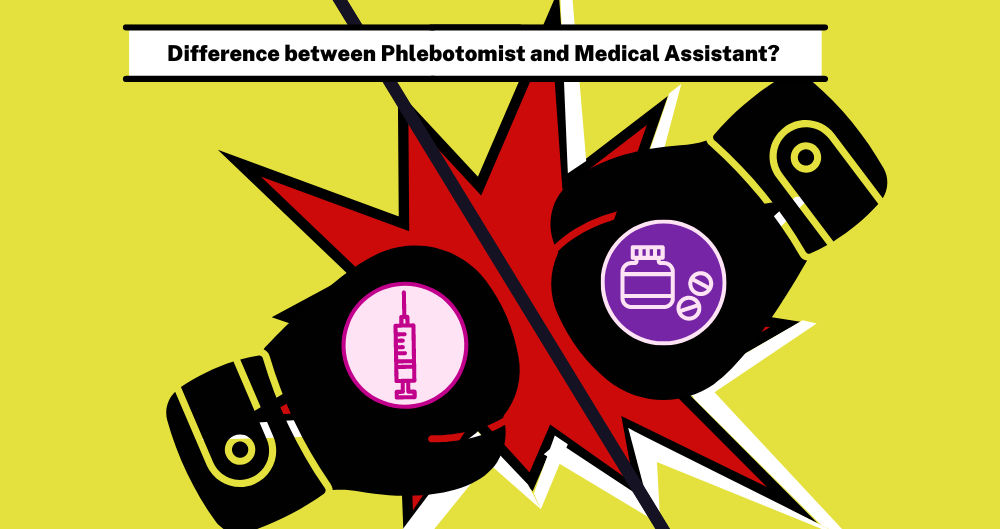Phlebotomist vs. Medical Assistant

Key Points:
- Phlebotomists focus on drawing blood; Medical Assistants have a broader range of duties, such as assisting with clinical procedures.
- Phlebotomists typically earn a slightly higher median hourly wage compared to Medical Assistants.
- Both jobs are in high demand.
- Phlebotomists often require a certificate program, while Medical Assistants can have either a certificate or an associate's degree.
- Phlebotomy training is generally shorter and less expensive than Medical Assistants.
A Phlebotomist is someone that performs blood draws. You can see them working at blood banks, diagnostic centers, and clinics. MAs also perform blood draws, but they also perform a wider variety of tasks.
Phlebotomy education and training requirements
To be a Phlebotomist, you must pass the National Certified Phlebotomy Technician (NCPT) test. Before taking the exam, you must first complete a training program. The test requires you to perform 100 successful venipunctures and 25 skin punctures.
A High School diploma or an equivalent is the only prerequisite to join a phlebotomy program. Then, you can enroll in a phlebotomy program—which usually requires 4-8 months of training. You can find Phlebotomy programs at trade schools, technical schools, and community colleges. Phlebotomists can choose from various certifications, including:
-
Certified Phlebotomy Technician I: Allows taking blood samples by venipuncture and skin punctures
-
Certified Phlebotomy Technician II: You can perform venipuncture, arterial puncture, and skin puncture
-
Limited Phlebotomy Technician: prepares medical personnel to collect blood through skin punctures
Training costs can range from $600 to $2,500. This is depending on the program and institution you enroll in.
MA education and training requirements
The path to becoming a MA is a little different compared to becoming a Phlebotomist. As an MA, you will need to graduate from either of the two accredited programs:
-
Accrediting Bureau of Health Education Schools (ABHES)
-
Commission on Accreditation of Allied Health Education Programs (CAAHEP).
MA programs might last anywhere from nine months and two years. Accredited MA programs cost between $1,000 and $3,000. To get a job right after, you must pass the CMA (AAMA) exam. You can also seek a degree instead of enrolling in a certificate program if you like.
Medical Assistant schools near me
Phlebotomist job outlook
Pursuing a career in phlebotomy is something you won’t regret. The BLS projects a 10% growth in the employment of Phlebotomists from 2021 to 2031—a lot faster than the average for most occupations. The median annual wage for Phlebotomists two years ago was $37,380 ($17.97/hr).
There are several ways to advance your phlebotomy career path. Obtaining a specialty may boost your yearly earnings and professional qualifications. Examples of phlebotomy specialties include:
-
Registered phlebotomy specialist
-
Collections phlebotomy specialist
-
Traveling Phlebotomist
-
Donor phlebotomy technician
Medical Assistant job outlook
Experts say that employment for MAs will grow 29% from 2016 to 2026. That's almost three times faster than the Phlebotomist employment growth rate! The mean annual wage for MAs is $40,700 ($19.57/hour). The top-paying states for MAs are Washington, D.C., Alaska, California, and Massachusetts—they all offer average annual salaries above $44,000.
MAs can take advantage of several opportunities to grow. Having a background will be a strong foundation for starting a healthcare business. You can also specialize depending on your passion for healthcare. Consider the following specialization if you want to further your career:
-
Pediatrics MA - this is perfect if you love working with kids
-
Oncology Office MA - Suitable for people who have a passion for working with cancer patients
-
Cosmetic Industry MA - if cosmetic procedures interests you, go for this option
Both Phlebotomists and MAs ensure a seamless flow of procedures in supporting medical professionals. They may have some differences in duties and training, but they share the same vision. They work together to guarantee the smooth functioning of healthcare facilities.
If it weren't for them, facilities and professionals would face challenges in working. Without Phlebotomists, blood collection and specimen processing would be more difficult. Also, Physicians and nurses may need to spend more time delivering various tasks if there are no MAs.
If you aspire to focus on venipunctures and blood drawing alone, go for being a Phlebotomist. While being a MA requires longer training and wider tasks, you’ll make a great contribution to the healthcare field either way.
Phlebotomists specialize in drawing blood from patients for diagnostic testing, transfusions, or donations. They are trained in venipuncture techniques and must follow strict protocols to ensure the accuracy and safety of the blood collection process. On the other hand, Medical Assistants have a broader scope of responsibilities. They perform both clinical tasks, such as taking vital signs, preparing patients for examinations, and administering injections, as well as administrative duties like scheduling appointments, managing medical records, and coordinating with insurance companies.



